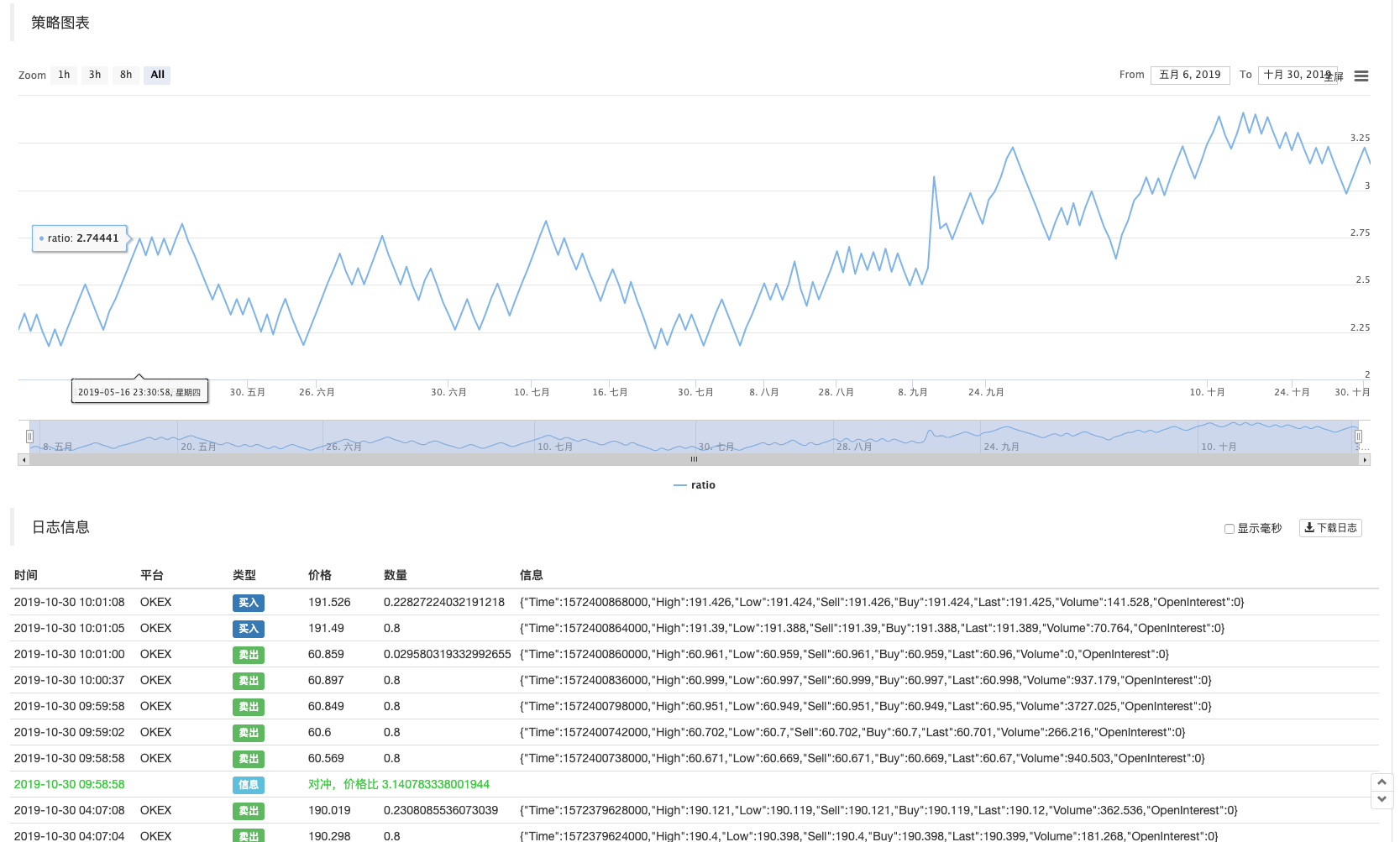Cross-currency hedging strategies in blockchain asset quantification
Author: Inventors quantify - small dreams, Created: 2019-11-04 11:44:15, Updated: 2023-10-17 21:25:35
Cross-currency hedging strategies in blockchain asset quantification
In hedging strategies, there are various types of hedging. Cross-market hedging, cross-term hedging, etc. Today we will talk about cross-variety hedging, more precisely, cross-currency hedging strategies in blockchain asset quantization trading. The usual items in the hedging transaction are the same, while cross-currency hedging is buying and selling different items. When we hedge the same varieties, we can use the price difference as the buy and sell price in the hedging transaction.
For example: A transaction pair is: LTC_USDT B is for: ETH_USDT
According toA交易对的价格/B交易对的价格This price ratio is a numerical value, a spread position. The larger this ratio is, the more we will sell A and buy B. The inverse ratio rule changes to buy A and sell B. An equal amount of USDT for each hedge is actually a strategy to trade on the grid at a relatively strong price of LTC/ETH. The strategic thinking is not complicated. However, it should be noted that this hedging combination, which is actually using ETH as a fixed-price currency to calculate LTC.
Using the inventor's quantitative trading platform, it is easy to write a strategy prototype:
When the policy code runs, it needs to be referenced. and
and "Draw Line Library" was created by a group of students.https://www.fmz.com/strategy/27293"Digital currency spot trading library": This is what each user brings with them in the template bar when they create a new strategy.
"Draw Line Library" was created by a group of students.https://www.fmz.com/strategy/27293"Digital currency spot trading library": This is what each user brings with them in the template bar when they create a new strategy.
/*backtest
start: 2019-05-01 00:00:00
end: 2019-11-04 00:00:00
period: 1m
exchanges: [{"eid":"OKEX","currency":"LTC_USDT","balance":100000,"stocks":30},{"eid":"OKEX","currency":"ETH_USDT","balance":100000,"stocks":30}]
*/
/*
A exchanges[0] : EOS_USDT
B exchanges[1] : ETH_USDT
*/
var Interval = 500
// 参数
var numPoint = 100 // 节点数
var distance = 0.08 // 比例间距
var amountPoint = 100 // 节点金额,单位USDT
var arrHedgeList = []
function main () {
var isFirst = true
while(true) {
var rA = exchanges[0].Go("GetTicker")
var rB = exchanges[1].Go("GetTicker")
var tickerA = rA.wait()
var tickerB = rB.wait()
if (tickerA && tickerB) {
var priceRatioSell = tickerB.Buy / tickerA.Sell // B sell , A buy
var priceRatioBuy = tickerB.Sell / tickerA.Buy // B buy , A sell
if (isFirst) {
for (var i = 0 ; i < numPoint ; i++) {
var point = {
priceRatio : priceRatioSell + (i + 1) * distance,
coverRatio : priceRatioSell + i * distance,
amount : (0.08 * i + 1) * amountPoint,
isHold : false,
}
arrHedgeList.push(point)
}
isFirst = false
}
for (var j = 0 ; j < arrHedgeList.length; j++) {
if (priceRatioSell > arrHedgeList[j].priceRatio && arrHedgeList[j].isHold == false) {
// B sell , A buy
Log("对冲,价格比", priceRatioSell, "#FF0000")
$.Buy(exchanges[0], arrHedgeList[j].amount / tickerA.Sell)
$.Sell(exchanges[1], arrHedgeList[j].amount / tickerB.Buy)
arrHedgeList[j].isHold = true
LogStatus(_D(), exchanges[0].GetAccount(), "\n", exchanges[1].GetAccount())
$.PlotLine("ratio", (priceRatioSell + priceRatioBuy) / 2)
break
}
if (priceRatioBuy < arrHedgeList[j].coverRatio && arrHedgeList[j].isHold == true) {
// B buy , A sell
Log("对冲,价格比", priceRatioBuy, "#32CD32")
$.Sell(exchanges[0], arrHedgeList[j].amount / tickerA.Buy)
$.Buy(exchanges[1], arrHedgeList[j].amount / tickerB.Sell)
arrHedgeList[j].isHold = false
LogStatus(_D(), exchanges[0].GetAccount(), "\n", exchanges[1].GetAccount())
$.PlotLine("ratio", (priceRatioSell + priceRatioBuy) / 2)
break
}
}
}
Sleep(Interval)
}
}
The first step is to verify a strategic idea by retesting it.
Use the default retesting setting:


As can be seen, it is very easy to implement a prototype of an idea using only a few dozen lines of code, and the inventor quantifies the trading platform. From the diagram above, this price ratio is mostly volatile, but there is a certain trend direction, and the optimization direction can be for position control when hedging or to join a certain trend recognition.
In the position control aspect, the amount of hedging for each hedging node can be incremented, for example in code:
if (isFirst) {
for (var i = 0 ; i < numPoint ; i++) {
var point = {
priceRatio : priceRatioSell + (i + 1) * distance,
coverRatio : priceRatioSell + i * distance,
amount : (0.08 * i + 1) * amountPoint, // 每次递增amountPoint的8%
isHold : false,
}
arrHedgeList.push(point)
}
isFirst = false
}
This allows relatively heavier positions to be concentrated in a position with a higher price ratio, avoiding taking too many positions when the price ratio is lower. Of course, such cross-currency hedging is risky and will result in a buffer if the price of one currency continues to rise relative to another, so cross-currency hedging requires a stronger correlation between the two currencies.
This strategy is just an initial demo and can be modified and optimized.
- Quantitative Practice of DEX Exchanges (2) -- Hyperliquid User Guide
- DEX exchange quantitative practices ((2) -- Hyperliquid user guide
- Quantitative Practice of DEX Exchanges (1) -- dYdX v4 User Guide
- Introduction to Lead-Lag Arbitrage in Cryptocurrency (3)
- DEX exchange quantitative practice ((1) -- dYdX v4 user guide
- Introduction to the Lead-Lag suite in digital currency (3)
- Introduction to Lead-Lag Arbitrage in Cryptocurrency (2)
- Introduction to the Lead-Lag suite in the digital currency (2)
- Discussion on External Signal Reception of FMZ Platform: A Complete Solution for Receiving Signals with Built-in Http Service in Strategy
- Discussing FMZ platform external signal reception: a complete set of strategies for the reception of signals from built-in HTTP services
- Introduction to Lead-Lag Arbitrage in Cryptocurrency (1)
- FMZ heartbeat pathway - leap forward strategy included
- Python's chase and kill strategy
- Python version of simple grid policy
- Quantified trading tools for open-source digital currency options
- Handshake teaches you how to write a K-line syntax in Python
- Handshake teaches you how to add support for multiple charts to a policy
- Linear hang single-stream strategy based on data playback feature development
- Hands-on to teach you how to transplant a Macanese language strategy (progress)
- Q&A about how to get started with cryptocurrency
- Inventors Quantify FMex Mining Strategy and Use Guide
- Modified Deribit futures API to accommodate options quantitative trading
- The hand teaches you how to write a strategy -- to translate a strategy into my language.
- Use research environments to analyze the impact of triangular hedging details and royalty on hedgeable price differentials
- Introducing FMZ Quant data science research environment
- Analysis of the strategy of the Dongguan corridor in the context of research
- Parabolic Steering SAR and Price High and Low Point Strategy
- Work ethic - learning how to use research environment to analyze trading principles
- Teach you how to let an old strategy docking the websocket quotes interface
- Similarities and differences between commodity futures and cryptocurrency exchanges API
- Handshake teaches you how to give an old-fashioned strategy a seamless websocket market interface